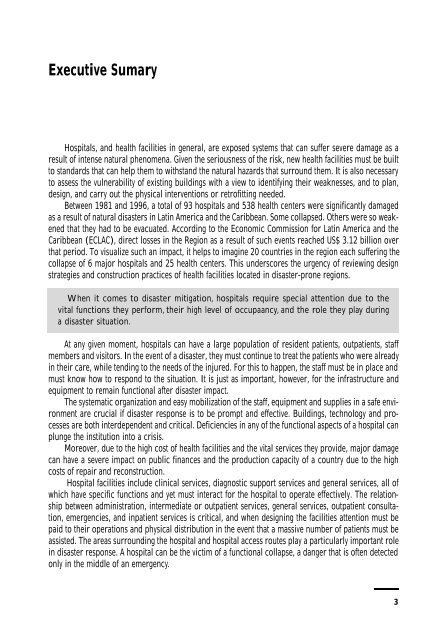Principles of Disaster Mitigation in Health Facilities - DISASTER info ...
Principles of Disaster Mitigation in Health Facilities - DISASTER info ...
Principles of Disaster Mitigation in Health Facilities - DISASTER info ...
Create successful ePaper yourself
Turn your PDF publications into a flip-book with our unique Google optimized e-Paper software.
Executive Sumary<br />
Hospitals, and health facilities <strong>in</strong> general, are exposed systems that can suffer severe damage as a<br />
result <strong>of</strong> <strong>in</strong>tense natural phenomena. Given the seriousness <strong>of</strong> the risk, new health facilities must be built<br />
to standards that can help them to withstand the natural hazards that surround them. It is also necessary<br />
to assess the vulnerability <strong>of</strong> exist<strong>in</strong>g build<strong>in</strong>gs with a view to identify<strong>in</strong>g their weaknesses, and to plan,<br />
design, and carry out the physical <strong>in</strong>terventions or retr<strong>of</strong>itt<strong>in</strong>g needed.<br />
Between 1981 and 1996, a total <strong>of</strong> 93 hospitals and 538 health centers were significantly damaged<br />
as a result <strong>of</strong> natural disasters <strong>in</strong> Lat<strong>in</strong> America and the Caribbean. Some collapsed. Others were so weakened<br />
that they had to be evacuated. Accord<strong>in</strong>g to the Economic Commission for Lat<strong>in</strong> America and the<br />
Caribbean (ECLAC), direct losses <strong>in</strong> the Region as a result <strong>of</strong> such events reached US$ 3.12 billion over<br />
that period. To visualize such an impact, it helps to imag<strong>in</strong>e 20 countries <strong>in</strong> the region each suffer<strong>in</strong>g the<br />
collapse <strong>of</strong> 6 major hospitals and 25 health centers. This underscores the urgency <strong>of</strong> review<strong>in</strong>g design<br />
strategies and construction practices <strong>of</strong> health facilities located <strong>in</strong> disaster-prone regions.<br />
When it comes to disaster mitigation, hospitals re q u i re special attention due to the<br />
vital functions they perfo r m , their high level <strong>of</strong> occupaancy, and the role they play dur<strong>in</strong>g<br />
a disaster situation.<br />
At any given moment, hospitals can have a large population <strong>of</strong> resident patients, outpatients, staff<br />
members and visitors. In the event <strong>of</strong> a disaster, they must cont<strong>in</strong>ue to treat the patients who were already<br />
<strong>in</strong> their care, while tend<strong>in</strong>g to the needs <strong>of</strong> the <strong>in</strong>jured. For this to happen, the staff must be <strong>in</strong> place and<br />
must know how to respond to the situation. It is just as important, however, for the <strong>in</strong>frastructure and<br />
equipment to rema<strong>in</strong> functional after disaster impact.<br />
The systematic organization and easy mobilization <strong>of</strong> the staff, equipment and supplies <strong>in</strong> a safe environment<br />
are crucial if disaster response is to be prompt and effective. Build<strong>in</strong>gs, technology and processes<br />
are both <strong>in</strong>terdependent and critical. Deficiencies <strong>in</strong> any <strong>of</strong> the functional aspects <strong>of</strong> a hospital can<br />
plunge the <strong>in</strong>stitution <strong>in</strong>to a crisis.<br />
Moreover, due to the high cost <strong>of</strong> health facilities and the vital services they provide, major damage<br />
can have a severe impact on public f<strong>in</strong>ances and the production capacity <strong>of</strong> a country due to the high<br />
costs <strong>of</strong> repair and reconstruction.<br />
Hospital facilities <strong>in</strong>clude cl<strong>in</strong>ical services, diagnostic support services and general services, all <strong>of</strong><br />
which have specific functions and yet must <strong>in</strong>teract for the hospital to operate effectively. The relationship<br />
between adm<strong>in</strong>istration, <strong>in</strong>termediate or outpatient services, general services, outpatient consultation,<br />
emergencies, and <strong>in</strong>patient services is critical, and when design<strong>in</strong>g the facilities attention must be<br />
paid to their operations and physical distribution <strong>in</strong> the event that a massive number <strong>of</strong> patients must be<br />
assisted. The areas surround<strong>in</strong>g the hospital and hospital access routes play a particularly important role<br />
<strong>in</strong> disaster response. A hospital can be the victim <strong>of</strong> a functional collapse, a danger that is <strong>of</strong>ten detected<br />
only <strong>in</strong> the middle <strong>of</strong> an emergency.<br />
3

















